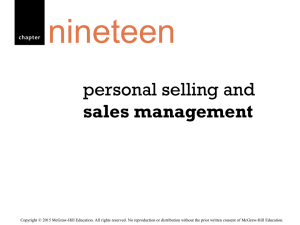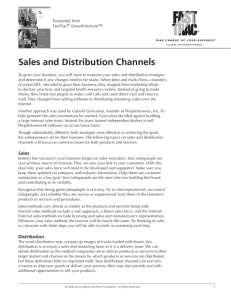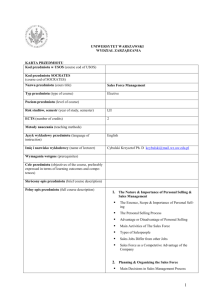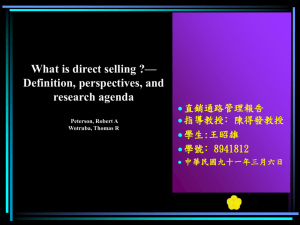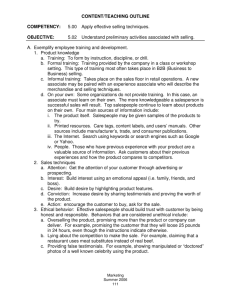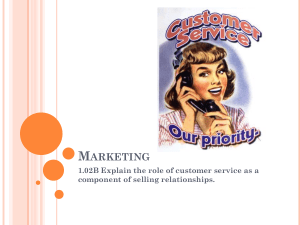Presentation 7
advertisement
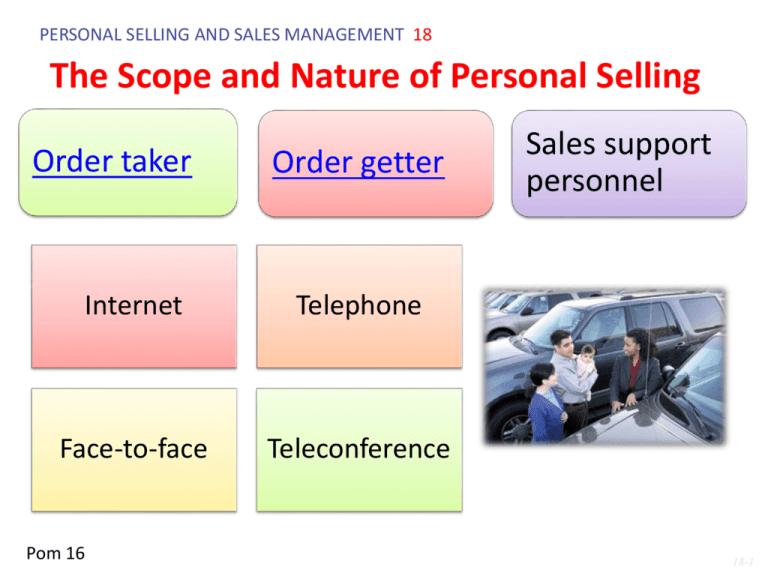
PERSONAL SELLING AND SALES MANAGEMENT 18 The Scope and Nature of Personal Selling Order taker Order getter Internet Telephone Face-to-face Teleconference Pom 16 Sales support personnel 18-1 Personal Selling and Marketing Strategy 1. Can customize the message for a specific buyer 2. Assists in creating strong supply chain relationships 3. Increased customer loyalty through relationship selling 4. Gather research input from customers 5. Crucial to the success of CRM 18-2 The Value Added by Personal Selling • Salespeople Provide Information and Advice • Salespeople Save Time and Simplify Buying • Salespeople Build Relationships Relationship selling is a sales philosophy and process that emphasizes a commitment to maintaining the relationship over the long term and investing in opportunities that are mutually beneficial to all parties. 18-3 Professional Selling as a Career • People love the lifestyle • There is a lot of flexibility • There is a lot of variety in the job • Can be very lucrative • Very visible to management and good for promotions 18-4 Personal Selling Process Step One: Generate and Qualify Leads Current Customers Trade Shows Sources of Leads Networking Events The Internet 18-6 Step Two: Preapproach Extends the qualification procedure Set goals for what is to be accomplished 18-7 Step Three: Sales Presentation and Overcoming Reservations The presentation Handling reservations 18-8 Step Four: Closing the Sale • Getting the order • Often most stressful part of sales process • A “no” one day may be the foundation for a “yes” another A B C 18-9 Step Five: Follow-Up Five Service Quality Dimensions 1. Reliability – Ability to perform the service dependably and accurately 2. Responsiveness – Willingness to help customers and provide prompt service 3. Assurance – Knowledge of and courtesy by employees and their ability to convey trust and confidence 4. Empathy – The caring, individualized attention provided to customers 5. Tangibles – The appearance of physical facilities, equipment, personnel and communication materials 18-10 Managing the Sales Force 1. Sales Force Structure Company sales force Manufacturer’s representatives (independent agents) Employees Not employees Established product lines Smaller firms New markets 18-11 Managing the Sales Force 2. Recruiting and Selecting Salespeople 18-12 Managing the Sales Force 3. Sales Training Selling and negotiation techniques Products and service knowledge Technologies used in the selling process Time and territory management Company policies and procedures 18-13 Managing the Sales Force 4. Motivating and Compensating Salespeople GRANTLAND® Copyright Grantland Enterprises; wwwgrantlandnet Financial rewards Nonfinancial rewards 18-14 Managing the Sales Force 5. Evaluating Salespeople • Tied to the reward structure • Evaluation measures can be either objective or subjective BananaStock/PictureQuest 18-15

